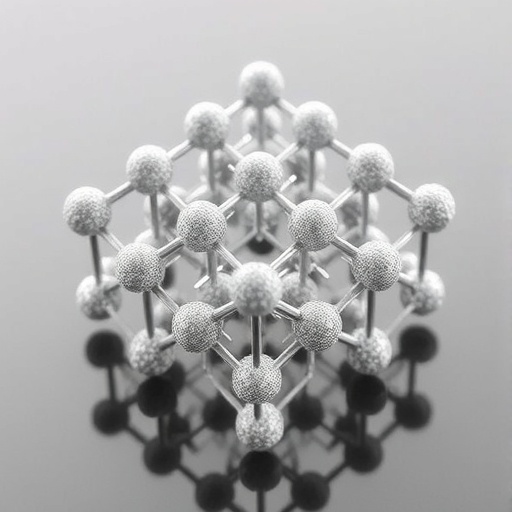In recent years, the increasing concern over environmental pollution has intensified the quest for innovative and sustainable methods to remediate harmful dyes from wastewater. Among these pollutants, methyl orange, an azo dye commonly used in textile industries, poses significant ecological risks due to its toxicity and persistence in the environment. The imperative to develop effective solutions has led researchers to explore advanced photocatalytic techniques, particularly the application of nanostructured photocatalysts. A groundbreaking study sheds light on the remarkable capabilities of nickel oxide and graphitic carbon nitride composites in degrading methyl orange when exposed to visible light.
Researchers Altilasi, Aldosari, and Hossain, along with their team, have made significant strides in the field of photocatalysis. Their innovative approach hinges on harnessing the unique properties of nickel oxide (NiO) combined with graphitic carbon nitride (g-C₃N₄) to create a composite that demonstrates enhanced efficacy in the photocatalytic degradation of methyl orange dye. This study marks a pivotal shift towards sustainable and efficient methods for dye removal in wastewater treatments, blending environmental science with material engineering.
The underlying mechanism of the photocatalytic process involves the absorption of visible light by the NiO/g-C₃N₄ composite, which excites electrons, subsequently generating electron-hole pairs. These pairs initiate redox reactions that lead to the formation of reactive species capable of breaking down organic contaminants like methyl orange. The researchers meticulously optimized several parameters, including catalyst composition, light intensity, and dye concentration, to enhance the photocatalytic activity of the composite.
One of the study’s remarkable findings is the optimal ratio of NiO to g-C₃N₄ that maximizes the photocatalytic efficiency. By adjusting this ratio, the researchers observed significant improvements in the degradation rates of methyl orange, suggesting that the synergistic interaction between NiO and g-C₃N₄ plays a crucial role in enhancing photocatalytic performance. The results offer promising insights for the development of cost-effective and scalable photocatalysts that can be employed in treating industrial wastewater.
Additionally, the study addressed the stability and reusability of the NiO/g-C₃N₄ composite, key factors when considering practical applications. Through rigorous testing over multiple cycles, the researchers demonstrated that the photocatalyst maintains its effectiveness, showcasing only a slight decline in activity over time. This resilience positions the composite as a viable candidate for long-term wastewater treatment solutions, fulfilling environmental regulations while minimizing costs.
The visible light-assisted nature of this photocatalytic method adds to its appeal, particularly in regions with abundant sunlight. Utilizing natural light not only makes this process more energy-efficient but also aligns with global goals for sustainable development. The promise of a low-energy method for remediating toxic dyes opens avenues for integrating such technologies into existing wastewater treatment systems.
Furthermore, the study highlights a significant breakthrough in tuning the bandgap of the nanostructured composite, which is pivotal for enhancing light absorption capabilities. By fine-tuning the physical and chemical properties of the materials used, the researchers achieved a composite that is highly responsive to visible light, marking a substantial advancement over traditional photocatalysts that primarily operate under UV light.
As the research community continues to grapple with the challenges of wastewater management, the implications of these findings are multifaceted. The potential for applying the NiO/g-C₃N₄ composites extends beyond just methyl orange; it opens the door for targeted solutions for other organic pollutants often found in industrial effluents. The adaptability of this technology could lead to comprehensive solutions for diverse contamination issues, thus contributing to cleaner water bodies.
Public awareness about the impacts of wastewater pollution is gradually growing, making innovations like this one increasingly relevant. The success of this research could inspire further studies aimed at expanding the library of photocatalysts available for various applications, ultimately driving forward the field of green chemistry. Emphasizing environmental sustainability in research and application aligns with global priorities, drawing attention to the need for robust environmental solutions.
Moreover, the intersection of materials science and environmental chemistry demonstrated in this study exemplifies how interdisciplinary approaches can address pressing global challenges. Collaborations among chemists, environmental scientists, and material engineers are essential for developing innovative solutions that are not only effective but also practical in real-world applications.
As we look towards implementing these advanced photocatalytic systems, further investigation into the long-term environmental impact of the composite materials themselves will be crucial. Understanding how these nanostructures behave in natural environments will ensure that new technologies do not inadvertently contribute to the very problems they seek to solve.
The promising results from this study could revolutionize the way industries approach wastewater treatment and pollution management. An effective and sustainable technique for degrading hazardous dyes like methyl orange could redefine standards and best practices, paving the way for a cleaner future. The integration of such technologies will be instrumental in achieving environmental sustainability goals across various sectors.
In summary, the innovative work by Altilasi and colleagues demonstrates not only the feasibility of utilizing NiO/g-C₃N₄ composites for effective dye degradation but also highlights the broader implications for wastewater treatment solutions worldwide. With a combination of high efficiency, stability under operational conditions, and a reduced environmental footprint, this research marks a significant step towards sustainable industrial practices.
Subject of Research: Photocatalytic degradation of methyl orange dye using NiO/g-C₃N₄ composites.
Article Title: Harnessing the visible light-assisted photocatalytic annihilation of methyl orange dye through nanostructured NiO/g-C₃N₄ composites: optimization of photocatalytic parameters.
Article References:
Altilasi, H.H., Aldosari, E., Hossain, M.A. et al. Harnessing the visible light-assisted photocatalytic annihilation of methyl orange dye through nanostructured NiO/g-C3N4 composites: optimization of photocatalytic parameters.
Ionics (2025). https://doi.org/10.1007/s11581-025-06837-6
Image Credits: AI Generated
DOI:
Keywords: photocatalysis, methyl orange, NiO, g-C₃N₄, wastewater treatment, visible light, environmental sustainability.




